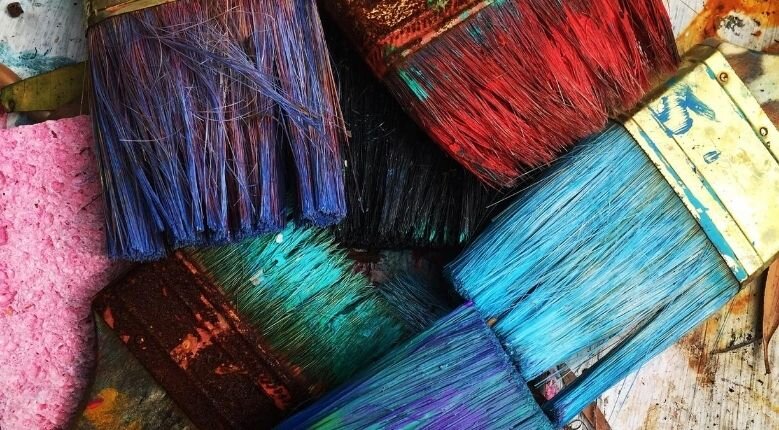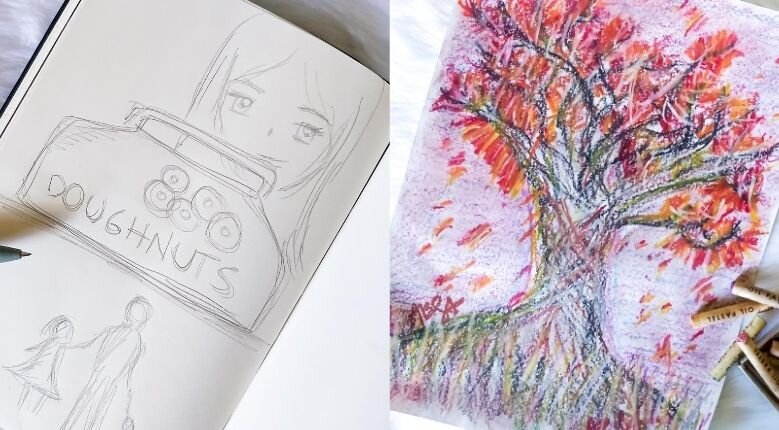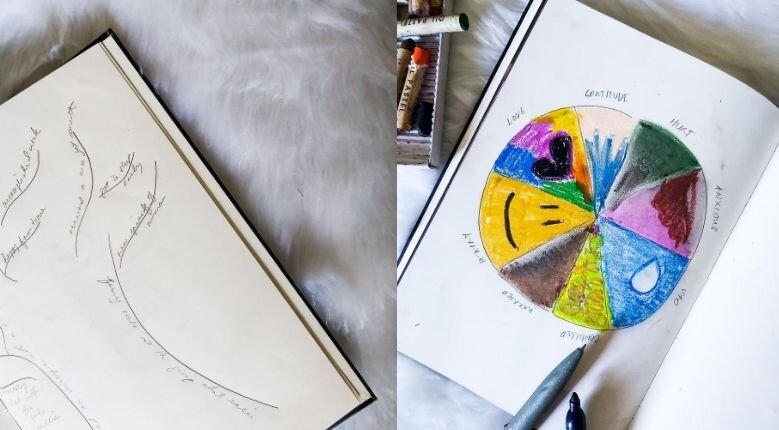When we think of art, we often think of something grandiose in nature, like a masterpiece worthy to be in a museum or a song that moves the hearts of millions. On the other hand, when the word ‘therapy’ comes into the picture, we often think of something a lot more technical and clinical. But according to Soul Mechanics' art therapist Dana Kaarina, these two things, when combined, are a lot more than these preconceived notions.
“To put it simply, art therapy is a form of psychotherapy that uses visual art media as its proxy mode of communication. Through art-making, people can express and explore feelings that may be difficult to communicate verbally,” she explained.
Given the constraints of our current pandemic-centric routines, seeking professional art therapy is still a bit bleak. But, through the guidance of Dana, I decided to try out art therapy at home to see if it will ease day-to-day anxieties.
Defining art therapy
Full disclosure: I am not an artistic person. I can be creative in different aspects, but when it comes to creating art that’s brag-worthy, it feels like a different area in my book.
Still, as someone who enjoys occasional sketching and scribbling from time-to-time, I wanted to find out if this type of coping mechanism has more to do with the process rather than the end result. Thankfully, Dana confirmed that I should not feel intimidated.
“Art therapy involves a three-way, triangular relationship between the client, therapist, and artwork. So basically anything done without the presence of an art therapist will be considered more of ‘art as therapy’ or using art as a therapeutic tool,” said Dana.

Art therapy doesn't end at creation but becomes holistic when you combine it with reflecting (Photo from: RhondhaK Native Florida Folk Artist via Unsplash)
This differentiates art therapy from the likes of just doing sketches or going for the popular trend of adult colouring books. However, Dana clarified that art therapy isn’t meant to psychoanalyse people who do it.
“Oh, how I wish it was that easy. We are mainly focused on the
process of art-making and of course the images [produced] as well. But rather than being able to analyse the work just like that, we help the client explore emotions or feelings that are brought up during the process. We work by asking questions and exploring these feelings together with the client. A lot of the time, the therapeutic process along with the art-making involves a lot of reflecting.”
With this, Dana provided me with a seven-day plan to follow to see if, at the moment with everyone still being pretty cautious to leave their homes for a period of time, I can practice these methods and reap of its therapeutic effects.
Art therapy at home, day one: hand self-portrait
Dana's instructions: “This activity is a simple way to share different parts of your personality or how you’re feeling that day (up to you). The idea is to fill in the hands with whatever you feel like (try not to think about it too much, just draw whatever comes to mind!). If you’re feeling stuck, I always suggest doodling or just writing any word that crosses your mind.
Draw an outline of one or both hands. Divide the hands into different sections that you will fill in with drawings, doodles, words, colours or patterns. It’s your call! Just remember to have fun.”
Initially, I thought: how hard can it be? Almost everyone has tried this activity before, most likely during their days in school, so I never imagined that as an adult, it would mean more than just what it is on the surface.
I had to admit that after the outline, being the overthinker that I am, the first couple of strokes felt a bit forced. But after shaking off all the noise inside my head, I just decided to really go for it.
This activity gave me a sense of balance: like feeling caged within the constraints of your hand’s outline but having the sense of freedom beyond just what is given for you to follow. To me, it felt like mimicking what being an adult is like — navigating through a restrained system but still being able to live to your own potential if you try. That gave me a very comforting feeling at the end of a tiring and somewhat frustrating day.

(Left) My hand self-portrait in which I wrote the word 'ganbare' meaning 'do your best' in Japanese; (Right) My attempt at Zentangle drawing.
Art therapy at home, day two: Zentangle drawing
Dana's instructions: “The zentangle drawing method is a drawing that uses structured patterns and lines to create a beautiful image. This method is a great way to reduce stress, increase focus and also improve hand and eye coordination.
Although this may be a little time consuming, the end results are always worth it! You’ll just need a paper and black pen for this and it’s up to you if you’d like to fill it in with colour. Don’t be overwhelmed by how it looks — trust me, you’ll get the hang of it!”
I’ve always been terribly clumsy and that is usually a testament to how poor my hand-eye coordination is. However, as someone who loves very crisp and clean patterns, this one proved to be one of my favourite activities. There’s something about repetitive patterns that give me a sense of control and calming sensation and while my end result isn’t something I’d hang proudly on our fridge, I still feel a sense of pride looking at it.
Art therapy at home, day three and four: draw a childhood memory and draw your breath
For the first activity, I chose a memory from my early childhood with my grandfather. He used to take me to his tennis matches when I was a kid and we would often share doughnuts from this specific shop after. After his passing a couple of years ago, I always end up buying doughnuts from the same shop whenever I feel sad or frustrated. I’ve never acknowledged the co-relation between the memory and action until I made this sketch, but now, it made sense that I always go back to that routine whenever I’m feeling down because it meant happier times.

(Left) My sketch of a childhood memory I'm fond of; (Right) My 'draw my breath' drawing that ended up as an autumnal fire tree.
As for the second activity, this felt quite nice because it meant just letting go and going for something more abstract. I still ended up sketching something that resembles an autumnal tree, a result of my love of structure and a bit of control, but it definitely felt great starting off without knowing what I’ll end up creating.
Art therapy at home, day five and six: gratitude tree and a colour wheel of emotions
The colour wheel of emotions, however, was a lot harder to process as it required associating ‘art’ to a certain level of feeling.
“Dr. Robert Plutchik stated that there are eight basic emotions: joy, trust, fear, surprise, sadness, anticipation, anger, and disgust. He created the wheel of emotions, which illustrates the various relationships among the emotions,” Dana explained.

(Left) My gratitude tree was rather simple, with the words and scribbles ending up looking like the tree's leaves; (Right) My interpretation of an emotion chart.
“Adapted to an art therapy theme, the wheel is divided into eight sections; think about different emotions that came up during the day. Then write the emotions above each section (on the outside of the diagram). The next step is to fill in each pie with a corresponding colour or picture that matches your idea of what the emotion means to you.”
This is probably the most challenging activity I had to do for this experiment and I’m still not sure why my final output turned out the way it did. All I know is that there’s a sense of accomplishment and awareness after doing it, which to the core is what’s important. I often thought of emotions for a certain day as monotonous — with just bouts of highs or lows on certain times of the day — but through this activity, it made me realise even 'moments of quiet' can also be related to specific emotions we go through on a daily basis, whether they're as heightened or not.
Art therapy at home, day seven: reflective drawing and writing
Dana's instructions: “Look through all the images and artwork you have made for the last six days. Then draw one image or a word that comes to mind when you’ve looked at all the work. This final image will be an image dedicated to how you feel in this present moment. If you don’t feel like drawing, feel free to write a word or a paragraph and just decorate the page.
After this, answer these questions and write them on the image: what's the biggest accomplishment you feel you’ve gained from the last week of engaging in these activities?; what's something you learned about yourself?; and write down five things you’re proud of yourself for.”

Culminating my experience is this reflective drawing made with oil pastels.
I ended up with a simple sketch filled with colour, much closer to my usual drawing style whenever I feel bored or anxious. However, this time, it felt a lot lighter, like closing the chapter on the past activities I’ve done over the week. This probably took the most time to create since I wanted to fill the page with as many colours as I can, reflecting the high-level emotions I didn’t expect would pop up throughout this experiment.
Is art therapy at home effective?
Dana advised: “Art therapy is for everyone! As long as you have an open mind to try it out, it could definitely benefit all kinds of people. A big misconception about art therapy is that it is mainly for children. This is not true but I understand why people would think that way. As adults, we tend to forget to nurture our creative minds because of all the responsibilities, lack of time, and basically other priorities in life. But I can assure you that making some time for yourself to engage in creative activities is always rewarding and fulfilling!”

Is art therapy effective? Yes. (Photo from: Luis Alfonso Orellana via Unsplash)
After an entire week of trying it out, I can proudly say that I attest to this myself. Despite its seeming simplicity on the surface, art therapy is such a personal experience that goes beyond just talking about how or what you feel. Whether you’re vocal about your emotions most of the time or have difficulty talking about it on a daily basis, this felt like a great avenue for letting all thoughts and feelings flow without the need for words or actions. In the end, it put very little thought or attention on the output, but rather the feelings that were conveyed in the process of each activity.
While I personally might not consistently follow this seven-day plan consecutively as I go about my routine, I will surely find a way to squeeze one or two of the activities from time-to-time whenever I need a breather. It is still advised to head the 'proper' route and consult with an art therapist if you are looking for long-term effects, but given today's social distancing situation, trying art therapy at home with this experiment as a guide is a great starter.
Do you see yourself trying this out too?
Speaking of art, should you support or not support controversial artists? We weigh in on that discussion here.
Comments, questions or feedback? Email us at [email protected].





.png)


